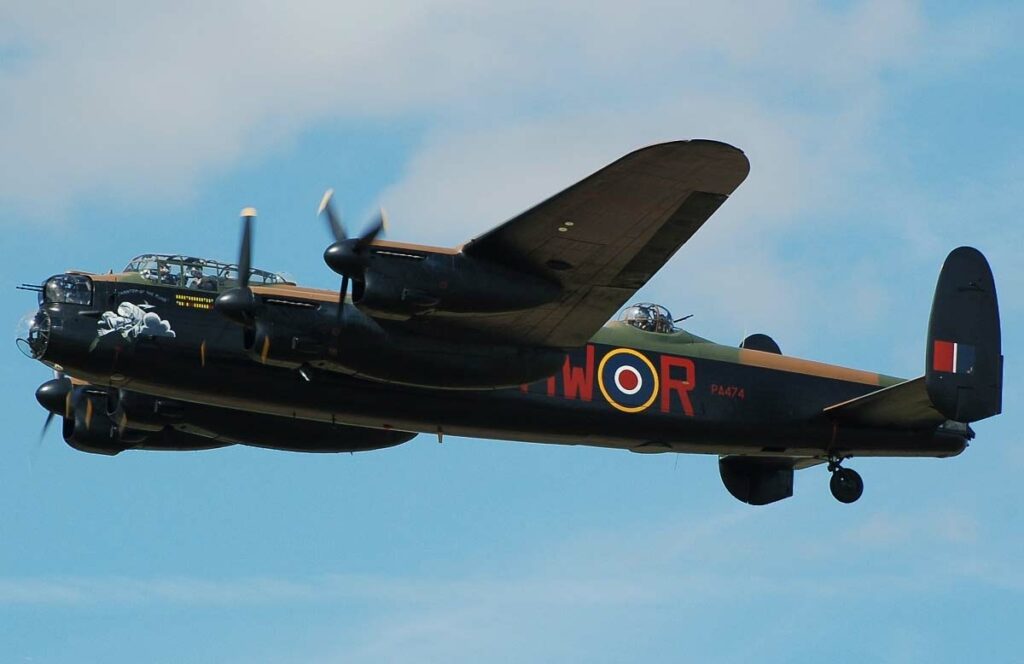The Avro Lancaster Mk.III, a significant WWII British heavy bomber, known for its high payload, four Rolls-Royce Merlin engines, and pivotal role in key operations.
This article offers a comprehensive analysis of the Avro Lancaster Mk.III, a key British bomber of World War II. It examines the historical context and development goals, emphasizing the need for a high-capacity, long-range bomber. The design section highlights its technical specifics, strengths, and limitations. The performance analysis situates the Lancaster Mk.III against its contemporaries, illustrating its superior capabilities. The military use section delves into its armament, operational roles, and impact in various conflicts, concluding with a reflection on its legacy and influence in aviation history.
The Avro Lancaster Mk.III stands as one of the most iconic British bombers of World War II, renowned for its significant contributions to the Allied bombing campaign.
History of the Development of the Avro Lancaster Mk.III:
Developed in the context of World War II, the Lancaster Mk.III was a response to Britain’s need for a capable heavy bomber. The Avro company, under the leadership of designer Roy Chadwick, initiated the project. The goal was to create a bomber with a greater payload capacity, range, and versatility than its predecessors.
The program was launched by the Royal Air Force to replace older bombers like the Handley Page Halifax and Short Stirling. The Lancaster Mk.III first flew on January 9, 1941. It did not have a NATO nickname, as it was developed and operated before NATO’s establishment.
Design of the Avro Lancaster Mk.III:
The Lancaster Mk.III was a marvel of design for its time. It had a wingspan of 31 meters (102 feet) and a length of 21 meters (69 feet). The most significant change in the Mk.III variant was the use of American-built Packard Merlin engines, each producing around 1,640 horsepower.
The aircraft could carry a maximum bomb load of up to 22,000 pounds (10,000 kilograms), which was remarkable for its era. The Lancaster’s design also featured a distinctive twin-tail and a streamlined fuselage, contributing to its aerodynamic efficiency.
However, the Lancaster had limitations, including vulnerability to fighter attacks and limited defensive armament. Nonetheless, its payload capacity and reliability outweighed these drawbacks.

Performance of the Avro Lancaster Mk.III:
The Lancaster Mk.III’s performance was outstanding. It could reach a top speed of 282 mph (454 km/h) and had a service ceiling of 24,500 feet (7,470 meters). Its operational range was approximately 2,530 miles (4,073 kilometers) with a reduced bomb load.
Compared to contemporaries like the American B-17 Flying Fortress, the Lancaster Mk.III had a higher payload capacity and comparable range, making it a formidable tool in the Allied bombing campaigns.
Military Use and Combat of the Avro Lancaster Mk.III:
The Lancaster Mk.III played a crucial role in various WWII operations. Its armament typically included eight .303 inch Browning machine guns for defense. It was used extensively in night bombing raids over Germany, including Operation Chastise (the “Dambusters” raid) and the Battle of Berlin.
The Lancaster’s ability to carry specialized payloads, like the “Grand Slam” bomb, allowed it to undertake missions that other bombers couldn’t. It faced competition from German anti-aircraft defenses and fighters but often succeeded due to its operational altitude and speed.
After the war, the Lancaster continued to serve in various roles and was operated by several countries, including Canada and Australia. It was eventually phased out in favor of newer jet bombers in the late 1950s.
The Avro Lancaster Mk.III remains a symbol of Britain’s air power during World War II. Its advanced design, impressive payload capacity, and operational versatility made it a key asset in the Allied war effort. The Lancaster’s legacy endures, not only as a testament to wartime engineering and innovation but also as a crucial part of aviation history.
Back to the Bombers section.